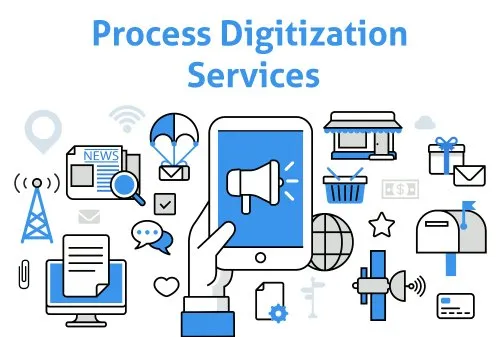
Process Digitization & Automation
Process Digitization & Automation: Transforming Business Through Technology and Efficiency
Introduction
In today’s hyper-competitive, digitally driven world, businesses must evolve rapidly to remain relevant and efficient. The traditional reliance on manual, paper-based, or siloed systems is no longer sustainable. To meet the growing demand for speed, transparency, scalability, and adaptability, organisations must undergo a fundamental shift in how they manage operations, serve customers, and drive innovation.
This shift begins with Process Digitization and Automation—a two-pronged strategy that transforms core operations by converting analog processes into digital formats and automating them for speed, accuracy, and efficiency.
This comprehensive guide explores the strategic impact of process digitization and automation, detailing the key principles, stages, benefits, tools, and future-forward trends that are shaping digital enterprise success.
1. Understanding the Concepts
1.1 What is Process Digitization?
Process digitization is the transformation of manual or analog processes into digital formats using technology. It involves converting physical documents, face-to-face interactions, and paper-based workflows into digital equivalents that can be accessed, tracked, and managed electronically.
Examples:
-
Replacing paper forms with online forms
-
Digitizing physical records into cloud databases
-
Converting in-person approvals into digital signatures
1.2 What is Process Automation?
Process automation is the use of software or technology to perform recurring tasks, decisions, or actions without human intervention. It often builds upon digitized processes to streamline operations, enforce rules, and eliminate redundancy.
Examples:
-
Automatically routing invoices for approval
-
Sending alerts for contract renewals
-
Generating reports on employee attendance
1.3 The Synergy Between Digitization and Automation
Digitization lays the groundwork for automation. You can’t automate what isn’t digitized. Once a process is digitally structured and standardized, automation can enhance it with speed, reliability, and intelligence.
2. The Strategic Importance
2.1 Foundation for Digital Transformation
Digitization and automation form the backbone of any digital transformation journey. They enable organisations to move from legacy systems and fragmented operations to integrated, intelligent processes that support long-term innovation.
2.2 Enabler of Data-Driven Decisions
By digitizing processes, businesses can collect valuable data at every step. Automation ensures that this data flows accurately and consistently, enabling analytics, forecasting, and real-time decision-making.
2.3 Scalability & Agility
As markets evolve and customer expectations change, digitized and automated processes can be rapidly modified and scaled without significant structural changes.
2.4 Customer Experience Transformation
Digitally automated processes reduce wait times, eliminate errors, and create seamless customer journeys—delivering satisfaction and loyalty.
3. Key Areas of Application
Digitization and automation apply across departments and industries. Here are some common use cases:
| Function | Digitized & Automated Processes |
|---|---|
| Finance | Expense claims, invoice approvals, financial reporting |
| HR | Onboarding, leave requests, payroll, performance reviews |
| Sales | Lead nurturing, proposal generation, order processing |
| Customer Service | Ticket management, feedback surveys, chatbots |
| Procurement | Vendor onboarding, purchase orders, approvals |
| Compliance | Audit trails, document versioning, regulatory filings |
4. Framework for Implementation
Successfully digitizing and automating processes requires a systematic and strategic approach:
4.1 Phase 1: Process Identification & Mapping
-
Identify high-impact, repetitive, or error-prone processes
-
Map current-state (as-is) workflows including all actors, inputs, and outcomes
-
Document pain points and opportunities for improvement
4.2 Phase 2: Digitization Strategy
-
Convert paper forms into digital forms or portals
-
Replace physical signatures with e-signatures
-
Use document management systems (DMS) for file storage and retrieval
4.3 Phase 3: Automation Design
-
Define business rules, decision points, and triggers
-
Select appropriate automation tools (workflow software, RPA, AI/ML)
-
Design future-state (to-be) workflows
4.4 Phase 4: Tool Selection & Integration
-
Choose platforms that align with business needs and integrate with existing systems
-
Options include:
-
Workflow engines (e.g., Kissflow, Nintex)
-
Robotic Process Automation (e.g., UiPath, Automation Anywhere)
-
Low-code platforms (e.g., Power Automate, Appian)
-
ERP/CRM with built-in automation (e.g., SAP, Salesforce)
-
4.5 Phase 5: Development & Testing
-
Build, configure, and test digitized forms and automated flows
-
Run test scenarios with actual users
-
Validate performance, reliability, and user experience
4.6 Phase 6: Deployment & Change Management
-
Launch in phases or by department
-
Train users, provide documentation, and offer support
-
Monitor adoption and handle feedback
4.7 Phase 7: Optimization & Scaling
-
Analyze usage data and performance metrics
-
Refine rules, adjust steps, and scale to more departments or functions
-
Introduce AI-based improvements and predictive capabilities
5. Tools and Technologies
| Category | Examples |
|---|---|
| Document Digitization | Adobe Acrobat, DocuSign, Nitro PDF |
| Workflow Automation | Kissflow, Pipefy, ProcessMaker |
| RPA (Robotic Process Automation) | UiPath, Automation Anywhere, Blue Prism |
| Low-Code Automation Platforms | Microsoft Power Automate, Appian, OutSystems |
| Data Capture & OCR | Abbyy, Kofax, Google Vision |
| Integration Platforms | Zapier, Make (Integromat), MuleSoft |
6. Benefits of Process Digitization & Automation
6.1 Improved Efficiency
Eliminates manual intervention, reduces turnaround times, and accelerates task completion.
6.2 Cost Reduction
Lower operational costs by minimizing paper use, administrative effort, and delays.
6.3 Enhanced Accuracy
Reduces errors caused by manual data entry, misplaced files, or miscommunication.
6.4 Greater Transparency
Digital audit trails and dashboards offer full visibility into every step of a process.
6.5 Better Compliance
Easier adherence to regulatory standards with time-stamped records, version control, and automated alerts.
6.6 Workforce Empowerment
Freeing employees from repetitive tasks allows them to focus on strategic initiatives and creative problem-solving.
7. Challenges and Mitigation Strategies
| Challenge | Mitigation Strategy |
|---|---|
| Legacy systems and resistance | Run change management campaigns, start small, and scale |
| Poor process documentation | Conduct workshops and stakeholder interviews |
| Integration issues | Use open platforms and robust APIs |
| Over-reliance on automation | Ensure human oversight in critical decision points |
| Security and data privacy | Use encrypted systems, role-based access, and compliance audits |
8. Industry Use Cases
8.1 Healthcare
-
Digitization: Patient records, prescriptions, lab reports
-
Automation: Appointment scheduling, billing, insurance claims
8.2 Manufacturing
-
Digitization: Production logs, quality control checklists
-
Automation: Equipment maintenance alerts, supply chain tracking
8.3 Education
-
Digitization: Admissions, transcripts, exams
-
Automation: Course registration, grading workflows, fee reminders
8.4 Government
-
Digitization: Permit applications, citizen records
-
Automation: License renewals, e-governance notifications, compliance tracking
9. Future of Process Digitization & Automation
9.1 AI-Powered Automation
Integrating machine learning models to:
-
Make predictive decisions
-
Recommend next-best actions
-
Automatically classify documents and detect anomalies
9.2 Intelligent Document Processing (IDP)
Combines OCR, NLP, and AI to extract, understand, and route information from unstructured documents.
9.3 Citizen Development
Empowering business users (non-IT) to design and deploy their own digitized workflows using low-code tools.
9.4 Hyperautomation
A strategic approach that combines RPA, AI, BPM (Business Process Management), and integration platforms to automate every possible business process end-to-end.
